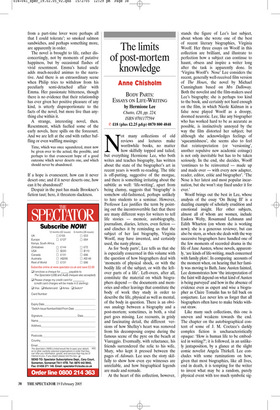The limits of post-mortem knowledge
Anne Chisholm
BODY PARTS: ESSAYS ON LIFE-WRITING by Hermione Lee Chatto, £20, pp. 224, ISBN 0701177594 V £18 (plus £2.25 p&p) 0870 800 4848 Not many collections of old reviews and lectures make worthwhile books, no matter how skilfully topped and tailed; but everything Hermione Lee, who both writes and teaches biography, has written about the state of the biographer’s art in recent years is worth re-reading. The title is off-putting, suggestive of the morgue, and there is something irritating about the subtitle as well: ‘life-writing’, apart from being clumsy, suggests that ‘biography’ is somehow old-fashioned, perhaps unlikely to lure students to a seminar. However, Professor Lee justifies the term by pointing out the incontrovertible fact that there are many different ways for writers to tell life stories — memoir, autobiography, journalism, diaries, letters, even fiction and clinches it by reminding us that the subject of her last biography, Virginia Woolf, may have invented, and certainly used, the nasty phrase.
As for ‘body parts’, Lee tells us that she is especially concerned in this volume with the question of how biographers deal with ‘moments of physical shock, or with the bodily life of the subject, or with the leftover parts of a life’. Left-overs, after all, constitute the material on which biographers depend — the documents and memories and other leavings that constitute the body of work they study in order to describe the life, physical as well as mental, of the body in question. There is an obvious analogy between a biography and a post-mortem; sometimes, in both, a vital part goes missing. Lee recounts, in grisly and fascinating detail, the different versions of how Shelley’s heart was removed from his decomposing corpse during the famous scene of the pyre on the beach at Viareggio. Eventually, with reluctance, his friends surrendered the relic to his wife, Mary, who kept it pressed between the pages of Adonais. Lee uses the story skilfully to show how even eye witnesses are unreliable, and how biographical legends are made and remade.
At the heart of this collection, however, stands the figure of Lee’s last subject, about whom she wrote one of the best of recent literary biographies, Virginia Woolf. Her three essays on Woolf in this collection are brilliant, and illustrate to perfection how a subject can continue to haunt, obsess and inspire a writer long after the task is apparently done. In ‘Virgina Woolf’s Nose’ Lee considers the recent, generally well-received film version of The Hours, the novel by Michael Cunningham based on Mrs Dalloway. Both the novelist and the film-makers used Lee’s biography; she is perhaps too kind to the book, and certainly not hard enough on the film, in which Nicole Kidman in a false nose played Woolf as a droopy, doomed neurotic. Lee, like any biographer who has worked hard to be as accurate as possible, is instinctively annoyed by the way the film distorted her subject; but although she acknowledges feelings of ‘squeamishness’, she seems also to feel that reinterpretation (or ‘versioning’, another repulsive new academic coinage) is not only inevitable but has to be taken seriously. In the end, she decides, Woolf ‘continues to be reinvented — made up and made over — with every new adapter, reader, editor, critic and biographer’. ‘The Nose is her latest and most popular incarnation, but she won’t stay fixed under it for ever.’ Woolf brings out the best in Lee, whose analysis of the essay ‘On Being Ill’ is a dazzling example of scholarly erudition and emotional insight. Her other subjects, almost all of whom are women, include Eudora Welty, Rosamund Lehmann and Edith Wharton (on whom she is working now); she is a generous reviewer, but can also be stern, as when she deals with the way successive biographers have handled one of the few moments of recorded drama in the life of Jane Austen, whose novels, apparently, ‘are kinds of life-writing, much concerned with family plots’. In comparing accounts of the moment when, on hearing that her family was moving to Bath, Jane Austen fainted, Lee demonstrates how ‘the interpretation of the faint will depend on what kind of Austen is being purveyed’ and how in the absence of evidence even as expert and wise a biographer as Claire Tomalin has to fall back on conjecture. Lee never lets us forget that all biographers often have to make bricks without straw.
Like many such collections, this one is uneven and weakens towards the end. The chapter on the autobiographical content of some of J. M. Coetzee’s darkly complex fiction is uncharacteristically opaque: ‘How is human life to be embodied in writing?’; it is followed, in an unlikely juxtaposition, by a glance at the slight comic novelist Angela Thirkell. Lee concludes with some ruminations on how, given that most biographies, like all lives, end in death, it is tempting for the writer to invest what may be a random, purely physical event with too much symbolic sig nificance. Once again, she turns to Virginia Woolf, whose suicide by drowning, despite being explained in the notes she left for her husband and sister, remains, like all the deepest human experiences, private and mysterious. It is one of Hermione Lee’s strengths that despite her intellectual confidence she knows when the interpretations have to stop.


















































 Previous page
Previous page